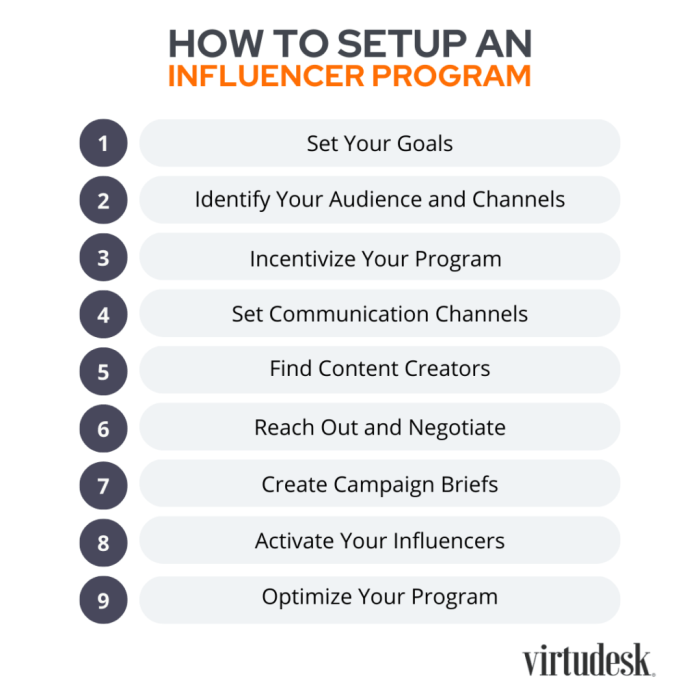Developing an Influencer Program dives into the world of brand partnerships and social media influencers, offering insight into the key components of a successful program. Get ready to elevate your brand with this comprehensive guide!
Ready to explore the ins and outs of influencer programs? Let’s dive in and uncover the secrets to creating a powerful brand presence through strategic partnerships with key influencers.
Understanding Influencer Programs
Influencer programs are marketing strategies that involve partnering with individuals who have a significant following on social media platforms. These influencers promote products or services to their audience in exchange for compensation, usually in the form of money, free products, or other perks.
Benefits of Developing an Influencer Program
- Increased brand awareness: Influencers can introduce your brand to a wider audience and help increase its visibility.
- Authenticity and trust: Consumers often trust recommendations from influencers they follow, leading to higher credibility for your brand.
- Engagement and reach: Influencers have the power to engage with their followers on a personal level, leading to higher levels of engagement and reach for your brand.
Key Components of a Successful Influencer Program
- Identifying the right influencers: Choose influencers whose values align with your brand and who have an engaged and relevant audience.
- Creative collaborations: Work with influencers to create authentic and engaging content that resonates with their followers.
- Clear goals and metrics: Define specific goals for your influencer program and track key performance indicators to measure its success.
Examples of Brands with Effective Influencer Programs
-
Lululemon:
The activewear brand partners with fitness influencers to showcase their products in action, reaching a health-conscious audience.
-
Sephora:
The beauty retailer collaborates with makeup artists and beauty influencers to create tutorials and reviews, driving product sales and brand awareness.
-
Daniel Wellington:
The watch company works with lifestyle influencers to showcase their watches in everyday settings, appealing to a fashion-forward audience.
Setting Objectives
Setting clear objectives for an influencer program is crucial for defining the purpose and direction of the campaign. Objectives help in aligning the activities of the influencers with the goals of the brand, ensuring a cohesive strategy that drives results. Additionally, setting objectives provides a benchmark for measuring the success and effectiveness of the influencer program.
Importance of Setting Objectives
- Clarifies the purpose and goals of the influencer program.
- Helps in aligning the influencers’ activities with the brand’s objectives.
- Provides a roadmap for the campaign, guiding decision-making and strategy.
- Allows for measuring the success and ROI of the influencer program.
Examples of Common Objectives for Influencer Programs
| Objective | Description |
|---|---|
| Increase Brand Awareness | Reach a larger audience and increase visibility for the brand. |
| Drive Sales and Conversions | Generate leads, increase sales, and drive conversions through influencer partnerships. |
| Build Brand Credibility | Enhance brand reputation and credibility by associating with trusted influencers. |
| Engage Target Audience | Create meaningful interactions with the target audience and increase engagement. |
How Objectives Help in Measuring Success
- Provide a clear benchmark for evaluating the performance of the influencer program.
- Enable tracking of key metrics and KPIs to measure the impact of the campaign.
- Facilitate adjustments and optimizations based on the progress towards the objectives.
- Help in demonstrating the ROI and effectiveness of the influencer partnerships.
Identifying Target Influencers

To successfully identify the right influencers for a program, brands need to conduct thorough research to ensure alignment with their values and target audience. This process involves evaluating factors such as engagement rates, audience demographics, and content authenticity.
Criteria for Selecting Influencers
- Relevance: Choose influencers whose content aligns with your brand’s values and target audience.
- Authenticity: Look for influencers who create genuine and relatable content that resonates with their followers.
- Engagement: Consider influencers with high engagement rates, as this indicates a strong connection with their audience.
- Reach: Evaluate an influencer’s reach to ensure they can effectively amplify your brand message to a wider audience.
Importance of Engagement Rates and Audience Demographics
- Engagement Rates: High engagement rates demonstrate that an influencer’s audience is actively interacting with their content. This means your brand message is more likely to be noticed and well-received.
- Audience Demographics: Understanding an influencer’s audience demographics helps ensure that your brand message reaches the right people. By targeting a relevant audience, you can increase the likelihood of conversions and brand affinity.
Compensation and Partnerships: Developing An Influencer Program
When it comes to compensating influencers in a program, there are several ways to go about it. Establishing clear partnerships with influencers is crucial for a successful collaboration. Negotiating terms and agreements with influencers requires open communication and understanding. Let’s dive deeper into these aspects below.
Different Ways to Compensate Influencers
- Flat Fee: Paying influencers a set amount for their content or services.
- Affiliate Marketing: Providing influencers with a commission based on sales generated through their unique referral link.
- Product Exchange: Sending influencers free products in exchange for promotion on their platforms.
- Sponsored Content: Compensating influencers to create and share sponsored posts about your brand.
Importance of Establishing Clear Partnerships
- Clear partnerships help to define expectations and responsibilities for both parties involved.
- Establishing trust and transparency is key to building a long-lasting relationship with influencers.
- Partnerships ensure that both the brand and the influencer are aligned in terms of goals and values.
Negotiating Terms and Agreements with Influencers, Developing an Influencer Program
- Define Objectives: Clearly Artikel what you expect from the influencer in terms of content, reach, and engagement.
- Set Clear Guidelines: Provide influencers with a detailed brief on the campaign requirements and any specific brand messaging.
- Discuss Compensation: Negotiate fair compensation based on the influencer’s reach, engagement rates, and the scope of work.
- Sign a Contract: It’s important to have a written agreement in place to protect both parties and ensure all terms are clearly defined.
Campaign Planning
Planning an influencer campaign involves several key steps to ensure its success. From setting clear objectives to collaborating with the right influencers, each step plays a crucial role in the overall strategy.
Creating Engaging Content Ideas
When brainstorming content ideas for influencers, it’s essential to think outside the box. Consider the target audience’s interests, trends in the industry, and the influencer’s unique voice. Here are some tips to create engaging content ideas:
- Encourage influencers to share personal stories or experiences related to your brand.
- Create interactive content such as polls, quizzes, or challenges to increase engagement.
- Showcase behind-the-scenes footage or sneak peeks to give followers an exclusive look.
- Collaborate with influencers on creative projects like photo shoots or videos to showcase your products in a unique way.
Aligning Campaign Goals with Influencer Content
Aligning campaign goals with influencer content is crucial for a successful partnership. By ensuring that the content created by influencers resonates with the brand’s objectives, you can maximize the impact of the campaign. It’s important to communicate clearly with influencers about the goals of the campaign and provide them with the necessary resources and information to create content that aligns with these objectives. Remember, authenticity is key in influencer marketing, so make sure the content feels genuine and natural to the influencer’s audience.
Monitoring and Measuring

In order to ensure the success of an influencer program, it is crucial to effectively monitor and measure the performance of influencers. This helps in determining the impact of the campaign and optimizing future strategies for better results.
Tools and Methods for Monitoring Influencer Performance
- Use influencer marketing platforms that provide real-time analytics and insights into the performance of influencers.
- Track key performance indicators (KPIs) such as engagement rates, click-through rates, conversion rates, and reach to evaluate the effectiveness of influencer collaborations.
- Implement UTM parameters to track traffic and conversions driven by influencers on your website or social media channels.
- Monitor social media mentions, comments, and shares to gauge the impact of influencer content on the audience.
Key Metrics to Track for Measuring Success
- Engagement Rate: Measure the level of interaction and engagement generated by influencer content, including likes, comments, and shares.
- Conversion Rate: Track the percentage of users who take a desired action after being exposed to influencer promotions, such as making a purchase or signing up for a service.
- Reach and Impressions: Evaluate the total number of people who have seen the influencer’s content to understand the campaign’s overall visibility.
- ROI (Return on Investment): Calculate the revenue generated compared to the total investment in the influencer program to determine the campaign’s profitability.
Analyzing Data to Optimize Future Influencer Campaigns
- Identify top-performing influencers based on key metrics and collaborate with them for future campaigns to maximize results.
- Adjust content strategies based on the analysis of audience engagement to create more impactful and relevant influencer collaborations.
- Experiment with different types of content, messaging, and platforms to understand what resonates best with your target audience and adapt future campaigns accordingly.
- Continuously monitor and analyze data throughout the campaign to make real-time optimizations and improvements for better performance.
